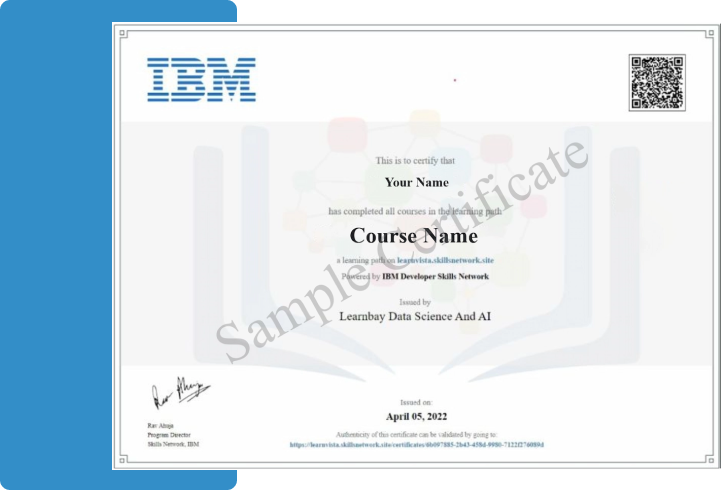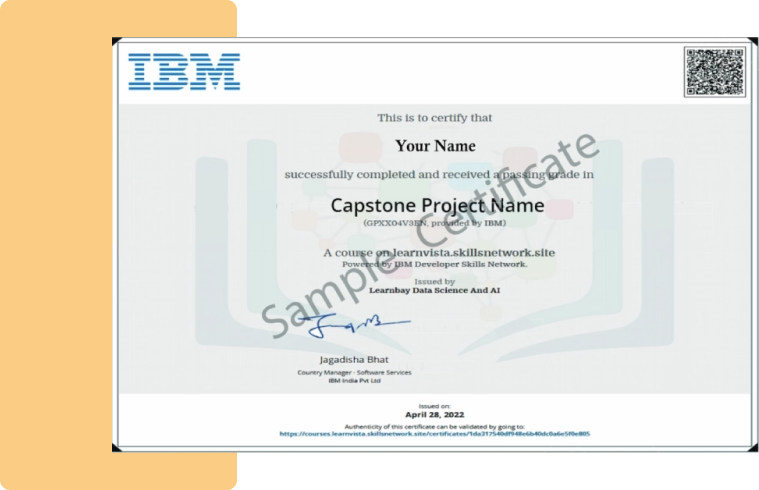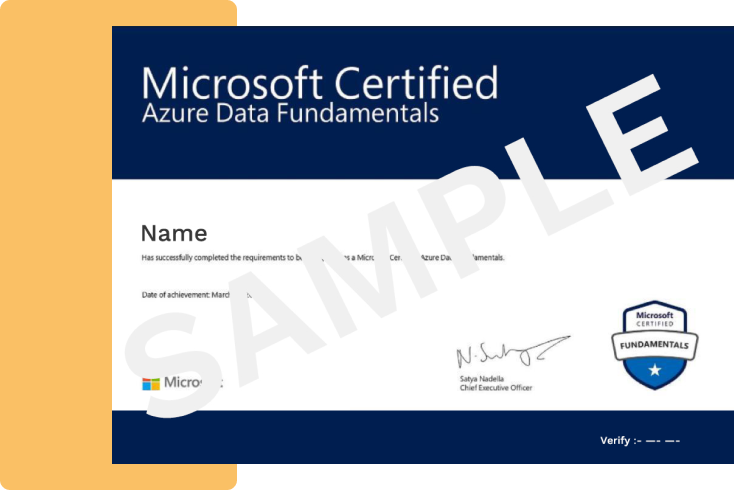Industry Curated Artificial Intelligence Program
Artificial Intelligence (AI) Training in Bangalore
Become a successful data science manager/leader within 11 months. Learn the secret data scientific tricks of managing data science projects. Learn directly from industry leaders via live classes and live projects.

In Collaboration With

In Collaboration With

1:1 Doubt Session
Guaranteed Interview Calls
IBM Project Certificate
Designed For Professionals
Our Alumni Speak
Discover the impact of our programs on career growth
Fee & Batch Details
Invest in your future with affordable program fees and flexible batch options
Scholarship Details

Scholarships are awarded based on profile review. Eligible candidates can avail upto 25% scholarship on desired program. Click the button below to apply.
Program Fee
₹ 1,15,000 + 18% GST
EMI Options
Pay in easy EMIs starting as low as
₹ 7,539/ Month
For No Cost EMI options click here.
Batch Details
Weekday Batch
May 17th
MON - FRI
8:00 AM - 10:00 AM
Weekday Batch
May 10th
MON - FRI
8:00 PM - 10:00 PM
Learnbay has enriched Artificial Intelligence (AI) training in Bangalore, guided and mentored by industry experts from MAANG companies. Learnbay's experts are dedicated to students' growth and career support. Domain electives are available to assure your full-stack Data science and AI expertise in your chosen industries. Learnbay AI training in Bangalore gives students real-time MNC and capstone project experience certified by IBM. Also, you get quick answers from the Learnbay Q&A forum and updated solutions for any queries with the least possible waiting time.
How does Learnbay artificial intelligence training become the most promising institute for experienced professionals in Bangalore?
Learnbay is such an institute that offers end-to-end professional, better to say, job-ready artificial intelligence training across Bangalore.
There are a number of Artificial Intelligence engineers or AI expert training providers in Bangalore, but Learnbay provides custom-fit training for successful AI career switch to experienced working professionals from any domain. The latest tools and updated modules are used to keep students on track with the present-day industry work scenario. This Artificial intelligence certification program also ensures guaranteed placement assurance.
Is Artificial intelligence a Good career in Bangalore?
Bangalore is a huge tech hub and works with the latest technologies to the best of its abilities. Irrespective of tech or non-tech industries, everyone is now getting extremely dependent on AI innovations. Hence the work culture, as well as the job market, demands in getting changes. But the number of candidates properly adaptable to such changes is very few.
Companies are facing different kinds of challenges as the advancement in technology by Artificial intelligence is big, but there are a few Artificial intelligence engineers/ experts. Learnbay wants to provide a solution for this by teaching the best Artificial Intelligence skills to learners who are eager to learn and own the ability for the same.
The best part at Learnbay is that you get the variable options of artificial intelligence courses to choose from- according to your career stage and professional background. Available course options are:
Data Science and AI Foundation Program with industry-specific training
Advanced Data Science and AI Program with domain specialization
AI & ML Program for tech professionals
Data Science and AI Program For Manager & Leaders
Data Science and AI master program
Why is domain specialization important in job-ready Artificial intelligence training in Bangalore?
Artificial intelligence has a lot of subsets and components. Expertising Artificial ,intelligence in specific domains gives an edge to your earned AI skills. If you pursue Learnbay Artificial intelligence course training in Bangalore, there are many domains to select from. The options include banking, oil, gas, etc. Every sector or industry has different requirements and work processes. Domain specialization helps you have an extra mark by completing this AI certification course. If you have already earned 4 years of experience in any domain, then in the present scenario, it's almost impossible to successfully switch into an AI career without domain-focused AI skills.
Learnbay's mentors and guides suggest the best domain for students after analyzing profiles and students' learning desires.
List of available Domain-Electivess
Learnbay Provides students with an IBM AI course completion certificate. This IBM-certified program helps you to be at the top of other profiles. The artificial intelligence course completion certificate by IBM ensures you are recognized as a skilled Artificial intelligence professional. Not only that, as you process with the modules, you get micro AI certifications by IBM like machine learning with python, Deep Learning with TensorFlow, and so on. As per your chosen course, you achieve 1 to 8 number micro certificates from IBM. Even once you complete the project, IBM issues a project experience certificate in AI too.



Learnbay artificial intelligence and ML training in Bangalore include 400 hrs of uninterrupted live classes conducted by MAANG experts. The foundational and advanced program also consists of 200+ sessions. The most impressive information is that all of these classes are completely live and interactive only. Students can attend multiple sessions of classes and instructors. Learnbay Provides 1- 3 years of flexi membership on artificial intelligence training so that students can learn at ease and in comfort from their devices. Students get to talk to mentors and guides with 1-1 live sessions to clear all their doubts. Our LMS is always updated with the latest version of courses and is altered according to the industry demands and standards. Here you get crisp industry-curated training on R, NLP, artificial neural networks, and so on.
Learnbay provides special basic coding classes and regular updates of coding assignments. Students can participate in Learnbay's exclusive hackathons and webinars.
Module Details:
Preparatory Classes (Programming + Maths)
6 Hours
Cohort Orientation
Data and its impact on career opportunities
Fundamentals of programming
Python Fundamentals
Fundamentals of Statistics
Mean, Median, Mode.
Statistics and Machine Learning
40 Hours
Fundamentals of Math and Probability
Descriptive Statistics
Inferential Statistics
Data Preprocessing
Logistic Regression Model
K Nearest Neighbours Model
Data Science Tools
70 Hours
SQL
MongoDB
Tableau
PowerBI
Big Data & Spark Analytics
Time Series
Artificial Intelligence Tools
12+ Classes
Deep Learning Using Tensorflow
Natural Language Processing (NLP)
Computer Vision
Reinforcement Learning
Deployment (AWS+Azure)
Model Training and Evaluation
Learnbay Artificial intelligence program in Bangalore ensures guaranteed placement assistance. Learnbay’s guides and mentors build your resume and portfolio and also refer your profiles so that you get a interview calls. Other than the placement assistance AI course, even in other courses, you get at least the promise of assured AI job interviews in Bangalore.
What are the job roles you find in Bangalore as an Artificial engineer?
Artificial Intelligence has created a lot of new job roles like:
Artificial intelligence Engineer.Machine learning engineer.Research scientist.Business intelligence developer.Data scientist.Big Data Engineer.Robotics Scientist.
Learnbay has enriched Artificial Intelligence (AI) training in Bangalore, guided and mentored by industry experts from MAANG companies. Learnbay's experts are dedicated to students' growth and career support. Domain electives are available to assure your full-stack Data science and AI expertise in your chosen industries. Learnbay AI training in Bangalore gives students real-time MNC and capstone project experience certified by IBM. Also, you get quick answers from the Learnbay Q&A forum and updated solutions for any queries with the least possible waiting time.

Samsung Health Monitor App
Samsung will launch a new healthcare app soon. The key goal of this app is accurate human activity tracking and providing relevant health-related recommendations. Continuous analysis of a massive amount of mobile data is required for such an app.

IBM HR Analytics
IBM intends to boost its HR department by identifying employees' masked inconsistency. They need models to identify the graphical variations in their 14000+ employees' performances. Help them build models with your regressions and other Data science abilities.

Amazon Customer Review Analysis
Amazon has made a goal to identify the most successful consumer electronic products. For these, they require live customer review analysis. You can participate in the assisting project of customer insight regeneration from the ongoing and existing reviews via a suitable data visualization approach.

BMW Used Car Price Optimization
BMW allows existing customers to sell used cars but many competitors are now offering better resale values. A data science-powered statistical app from BMW will provide the best market value for used cars based on parameters like Km driven, daily pricing up and down, manufacturing dates, etc. Develop your analytical skills through such projects.
Learnbay’s Artificial Intelligence training in Bangalore placement assurance for students and has emplaced thousands of students in the top companies and MNCs all over Bangalore. We have a few stories who have worked hard and have gained success by Learning the Artificial intelligence course at Learnbay.

Deveraj
The quality of the content is very nice. What I liked the most was mainly the instructor concentrating on the practical part, live project sessions make you feel confident to attend interviews. Multiple batch options, access for any instructor class videos or materials. The totally positive environment around.

Shezan Baig
Learnbay is one of the most remarkable data science institutes I've come across. Compared to other institutes in India, it offers a data science course at a low cost. Excellent value for money. Finally, I achieved job satisfaction. I would strongly advise everyone to attend this institute.

Viraj Ghodke
For me, learning using the Learnbay platform has been a great experience. The teaching and management team are very helpful. They are constantly willing to clarify each individual's doubts and meet the needs of working professionals. The practice interview sessions were simply like a clone of MNC interviews.

Shubhangi J. Waghmare
The best in Industry offerings from both cost and curriculum wise. One advantage of joining here is you can access their resources for a lifetime, unlike others where you have accessibility only for a year or so. Most importantly, there is continuous assistance for recruitment.
FAQs
Curriculum is specifically engineered to meet the expectations of leading tech companies.
What are Artificial Intelligence (AI) training courses available at Learnbay in Bangalore?
What are the prerequisites for these AI training Courses in Bangalore?
There are no prerequisites for this artificial certification course as all modules are beginner-friendly and are taught from scratch. We provide special classes and assistance for Non-IT/Non-programmers. However, basic knowledge of applied Mathematics/Statistics is a must.
What if I miss a few classes of Learnbay AI courses due to an emergency?
In case you miss a few classes, you will be provided with backup classes in other batches. But if you could not attend more classes, you can opt for batch change and join the next batch.
What is a Flexi Subscription in these advanced artificial intelligence courses in Bangalore?
Those who enroll for AI live classroom training are eligible for a Flexi Pass. With this option, we will share access to all the ongoing batch details for a period of 1 -3 years, so that you can attend live sessions from any batch and learn at your own pace. This option is best for people working in shifts or on weekends. Flexi Subscription Time-line: Foundational data science and Artificial Intelligence Training Course- 1 Year Advanced data science and AI Certification Course- 3 Years Machine learning and AI Certification- 3 Years Data Science and AI Certification Course for Managers and Leaders- 3 Years Data Science and Artificial Intelligence Training with Placement Assistance - 3-years
What’s the duration of these advanced AI in Bangalore?
The duration of these courses is about 6-15 months, which includes live lectures, hands-on practical training on live projects, and interview preparations. Classes will be conducted on weekdays and weekend batches. Monday to Friday - 2 hours/day and Saturday & Sunday - 3.5 hours/day Foundational Data Science and Artificial Intelligence Training Course (220+ hours) Weekday batch - 6 months Weekend batch - 8 months Machine learning and AI Certification (280+ hours) Weekday batch - 9.5 months Weekend batch - 11 months Advanced Data Science and AI Certification Course (270+ hours) Weekday batch - 7 months Weekend batch - 9 months Data Science and AI Certification Course for Managers and Leaders (340+ hours) Weekday batch - 11 months Weekend batch - 13 months Data Science and Artificial Intelligence Training with Placement Assistance (380+ hours) Weekday batch - 13 months Weekend batch - 15 months
What is the learning mode of Artificial Intelligence Certification courses in Bangalore at Learnbay?
We provide both classroom and online AI training modes. Based on your requirement, you can choose your preferred mode.
How can I opt for a Hybrid mode of learning in IBM artificial intelligence training courses in Bangalore, At Learnbay?
Simply, you can choose an online mode of study for the theoretical classes and a classroom mode for all the capstone projects and interview preparation sessions.
What are Artificial Intelligence (AI) training courses available at Learnbay in Bangalore?
What are the prerequisites for these AI training Courses in Bangalore?
There are no prerequisites for this artificial certification course as all modules are beginner-friendly and are taught from scratch. We provide special classes and assistance for Non-IT/Non-programmers. However, basic knowledge of applied Mathematics/Statistics is a must.
What if I miss a few classes of Learnbay AI courses due to an emergency?
In case you miss a few classes, you will be provided with backup classes in other batches. But if you could not attend more classes, you can opt for batch change and join the next batch.
What is a Flexi Subscription in these advanced artificial intelligence courses in Bangalore?
Those who enroll for AI live classroom training are eligible for a Flexi Pass. With this option, we will share access to all the ongoing batch details for a period of 1 -3 years, so that you can attend live sessions from any batch and learn at your own pace. This option is best for people working in shifts or on weekends. Flexi Subscription Time-line: Foundational data science and Artificial Intelligence Training Course- 1 Year Advanced data science and AI Certification Course- 3 Years Machine learning and AI Certification- 3 Years Data Science and AI Certification Course for Managers and Leaders- 3 Years Data Science and Artificial Intelligence Training with Placement Assistance - 3-years
What’s the duration of these advanced AI in Bangalore?
The duration of these courses is about 6-15 months, which includes live lectures, hands-on practical training on live projects, and interview preparations. Classes will be conducted on weekdays and weekend batches. Monday to Friday - 2 hours/day and Saturday & Sunday - 3.5 hours/day Foundational Data Science and Artificial Intelligence Training Course (220+ hours) Weekday batch - 6 months Weekend batch - 8 months Machine learning and AI Certification (280+ hours) Weekday batch - 9.5 months Weekend batch - 11 months Advanced Data Science and AI Certification Course (270+ hours) Weekday batch - 7 months Weekend batch - 9 months Data Science and AI Certification Course for Managers and Leaders (340+ hours) Weekday batch - 11 months Weekend batch - 13 months Data Science and Artificial Intelligence Training with Placement Assistance (380+ hours) Weekday batch - 13 months Weekend batch - 15 months
What is the learning mode of Artificial Intelligence Certification courses in Bangalore at Learnbay?
We provide both classroom and online AI training modes. Based on your requirement, you can choose your preferred mode.
How can I opt for a Hybrid mode of learning in IBM artificial intelligence training courses in Bangalore, At Learnbay?
Simply, you can choose an online mode of study for the theoretical classes and a classroom mode for all the capstone projects and interview preparation sessions.
24X7 Learner’s Support
Artificial Intelligence Course Certification Training locations in Bangalore :Ammrutha halli [560092], Maruthi Seva Nagar [560033], Kuvempu Layout [560077], Bellandur [560103], Jayanagar III Block [560011], Anandnagar [560024], Nandinilayout [560096], B SK II Stage [560070], Indiranagar [560038], Yelahanka [560063], Chickpet [560053], Domlur [560071], Bansashankari III Stage [560085], Vimanapura [560017], Nagarbhavi [560072], Basaveshwaranagar [560079], Bommanahalli [560068], Mico Layout [560076], Electronic City [560100], Taverekere [560029], Nehru Nagar [560020], Agram[560007], Halsuru Pete [560002], Basavanagudi [560004], R.M.V. Extension II [560094], Jayanagar [560041], Carmelaram [560035], New Thippasandra [560075], Kanakanagar [560032], Nayandahalli [560039], Fraser Town [560005], Jalahalli East [560014], Kacharakanahalli [560084], Malleswaram West [560055], Bannerghatta [560083], Srirampuram [560021], Rajarajeshwarinagar [560098], Sivan Chetty Gardens [560042], Dommasandra [562125], Whitefield [560066], Vidyaranyapura [560097], Bolare [560082], Mathikere [560054], Doddanekkundi [560037], Hampinnagar [560104], C.V.Raman Nagar [560093], Chikkabanavara [560090], Attur [560064], Kumbalagodu [560074], Bhattarahalli [560049], Chikkalasandra [560061], Sharada Nagar [560065], Jalahalli West [560015], H.K.P Road [560051], Jp Nagar III Phase [560078], Sadashiva nagar [560080], Krishnarajapuram R S [560016], Mahalakshipuram Layout [560086], Guddadahalli [560026], Chudenapura [560060], Vidhana Soudha [560001], Shanthinagar [560027], Rajaji Nagar [560010], Chandapura [560099], Ramakrishna Hegde Nagar [560045], Shalabh Bhatnagar [560012], Peenya [560058], Ashoknagar [560050], Jalahalli Nacen [560013], Banawadi [560043], Malleswaram [560003], Doddakallasandra [560062], K.G Road [560009], Muthusandra [560087], Marathahalli [560056], JC Nagar [560006], Chamrajpet [560018], HSR Layout [560102], Devanagundi [560067], Yeswanthpura [560022], Mahadevapura [560048],Hulsur Bazaar [560008],Magadi Road [560023], Adugodi [560030], Bagalgunte [560073], Devasandra [560036], Rv Niketan [560059], Narasimharaja Colony [560019], Koramangala VI Bk [560095], Agara [560034], Vijayanagar East [560040], Benson Town [560046], Viveknagar S.O [560047], Dasarahalli [560057], Bapagrama [560091], Richmond Town [560025].
Locations Offered :Artificial Intelligence Training in Bangalore, Artificial Intelligence Course in Bangalore, Artificial Intelligence Training in BTM, Artificial Intelligence Training in Marathahalli, Artificial Intelligence Institute in Bangalore, Artificial Intelligence Training in Whitefield, Artificial Intelligence Training in Kundalahalli, Artificial Intelligence Training in ITPL, Artificial Intelligence Training Institute in Marathahalli, Artificial Intelligence Course in BTM, Artificial Intelligence Course in Marathahalli, Artificial Intelligence Course in Whitefield, Artificial Intelligence Course Bommanahalli, Artificial Intelligence Training in Bommanahalli, Artificial Intelligence Training in Electronic city, Artificial Intelligence Training in Koramangala, Artificial Intelligence Classes in BTM, Artificial Intelligence Classes in Bommanahalli, Artificial Intelligence Classes in Whitefield, Artificial Intelligence Classes in Marathahalli, Artificial Intelligence Course in Koramangala, Artificial Intelligence Training in Jayanagar, Artificial Intelligence Certification in Bangalore, Artificial Intelligence Certification Training in Bangalore, Artificial Intelligence Certification in BTM, Artificial Intelligence Certification in Whitefield, Best Artificial Intelligence Training, Best Artificial Intelligence Course






